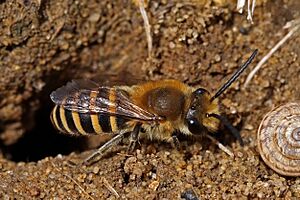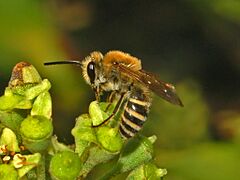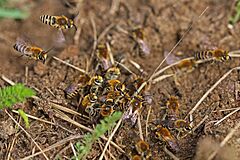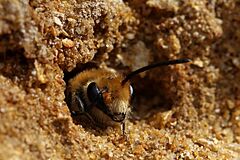Ivy bee facts for kids
Quick facts for kids Ivy bee |
|
|---|---|
 |
|
| male Dry Sandford Pit, Oxfordshire |
|
| Scientific classification | |
| Genus: |
Colletes
|
| Species: |
hederae
|
The ivy bee (scientific name: Colletes hederae) is a special type of bee. It belongs to a group called "plasterer bees" or "mining bees." These bees are known for building their nests in the ground.
Contents
Discovering the Ivy Bee
Scientists only recently identified the ivy bee as its own species in 1993. Before that, people often confused it with another bee called the sea aster mining bee (Colletes halophilus). Even though they look very similar, these two bees live in different places and have different habits.
Where Do Ivy Bees Live?
Ivy bees can be found in many parts of Europe. They live in countries like Austria, Belgium, Croatia, Cyprus, France, Germany, and Greece. You can also find them in Ireland, Italy, Luxembourg, and the Netherlands. They are also present in Serbia, Slovenia, Spain, Switzerland, and parts of the United Kingdom (southern England and Wales).
What Do Ivy Bees Look Like?
Ivy bees are medium-sized bees. Female ivy bees are usually about 13 millimeters (about half an inch) long. Males are a bit smaller, around 10 millimeters long. This makes them larger than many other common bees in their family.
Their bodies are covered in fuzzy, orange-brown hair. Each section of their abdomen (the back part of their body) has a bright orangey stripe of hair. They look very similar to their close relatives, like the heather colletes and the sea aster mining bee.
Ivy Bee Life and Habits
Ivy bees are "solitary bees." This means they don't live in big colonies like honeybees. Each female bee builds her own nest and cares for her young by herself. They do not live through the winter as adult bees.
When Do They Appear?
Adult ivy bees emerge late in the year. The males usually appear first in late August. The females come out a little later, in early September. You can see them flying around until early November.
What Do They Eat?
The main food source for ivy bees is the ivy plant (Hedera helix). Both male and female bees drink nectar from ivy flowers. Female bees also collect pollen from ivy flowers to feed their young. This is why they are called "ivy bees"!
If ivy flowers are hard to find, the bees might visit other plants. They sometimes collect pollen from plants in the Daisy family (Asteraceae).
Where Do They Build Nests?
Ivy bees like to build their nests in clay-sandy soils. They often choose soft-rock cliffs or hills made of a type of soil called loess. Even though they are solitary, many ivy bees might build their nests close together. Sometimes, you can find tens of thousands of nests in one area!
Who Are Their Enemies?
Like many other bees, ivy bees can have parasites. In some parts of Europe, a type of beetle larva called Stenoria analis can be a problem. These beetle larvae sneak into the ivy bee nests and eat the food (nectar and pollen) that the female bee collected for her own young.
Gallery





